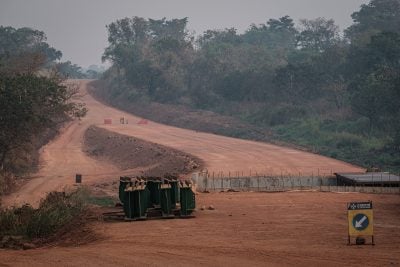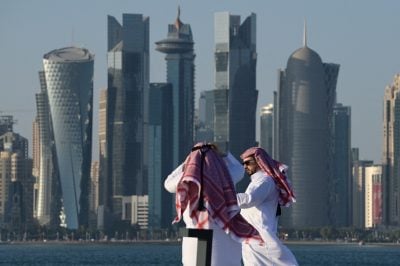South Africa’s railway system, which remained unchanged for 60 years, is now set to regain its dominant position in the country’s transport network. A new era began as the first of 70 new diesel locomotives chugged into Cape Town to signal the start of the new drive, writes Tom Nevin. But not everybody is pleased with the development.
It has taken over 60 years, but South Africa has at long last launched a new passenger locomotive, and with it a desperately needed new railway service.
More importantly, perhaps, the loco was designed by a South African team led by a black engineer, Dr Daniel Mtimkulu. The fleet of 71 new locos, costing a total of R46m ($4.6m), is the desperately needed start to shunting South Africa’s rail industry out of a dusty and derelict siding and beginning afresh.
The question now is: Can the government build up and maintain the momentum needed to return the railways to efficiency, reliability and profitability?
The new loco, the Afro 4000, was built in Spain to the Mtimkulu team’s design. Writer Chelsea Geach of the Cape Argus newspaper reports that many of Mtimkulu’s design innovations will continue to be used when a new train manufacturing plant in South Africa’s Gauteng province is completed.
No smooth ride lies ahead for the railway’s rebirth. CEO of the railways passenger services, Mosenngwa Mofi, concedes as much. “We are trying to keep alive a system that is terminally ill in the intensive care ward. You fix it today, tomorrow it breaks. That’s why commuters get frustrated and burn their assets.” (Referring to frequent setting fire to trains by passengers angered by constant breakdowns). Business Day newspaper reports that rail passenger services have been dogged by so many breakdowns, delays and cancellations that last year Metrorail began giving commuters letters to explain to their employers why they were late for work.
Mofi adds, however, that the new fleet is “the realisation of a dream that will change the travel experience of South Africans forever”.
The government and its fully-owned Transnet transport conglomerate are spending an awful amount of money – R300bn ($30bn), in fact – to show they’re serious about putting South Africa’s Humpty-Dumpty rail system back together again.
Transnet and its parent, the Department of Transport, say it was proof-positive of rail’s rebirth when the first Afro 4000 chugged impressively into Cape Town station. Representing South African rail’s new muscle, it will officially start operating with the Passenger Rail Service of South Africa (PRASA) in March and is the first new passenger loco to be commissioned in South Africa since 1958.
All aboard for a 21st century train ride
The new 4,000hp high-powered locomotives mark a turning point in the state-owned entity’s ambitious plans to modernise and rehabilitate South Africa’s railway network, a victim of neglect, ageing infrastructure and rolling stock and delays.
The state-of-the-technology locomotives were designed in Spain by rail component manufacturer Vossloh according to PRASA specifications to suit local conditions.
In all 71 new locos, including the newly-arrived one being used for testing and display, will enter long-haul service in South Africa over the next 30 or so months.
The upgrade procurement project was outsourced by PRASA to Swifambo Rail Leasing, a local company which, in turn, awarded the contract to Vossloh to supply the new high-tech locomotives at a cost of R3.5bn ($350,000).
Fifty-one of these will be Euro Dual electro-diesel and 20 are Euro 4000 diesel locomotives. The name change from Euro to Afro denotes the modifications for African conditions.
The locomotives have a display unit with various management systems that will allow the driver to detect and reset faults. They are the first in the country to have two driving cabs – meaning the train can travel in both directions without turning. The 4,000 horsepower locos can pull about 19 coaches.
“The critical factor is to improve the journey experience and encourage more long- distance travel,” says Mosenngwa Mofi, chief executive of PRASA Rail. “This can only be achieved by providing reliable, efficient locomotives to haul these trains with minimum en-route delays.”
PRASA will also acquire other new, modern trains over the next 10 years as part of a R51bn ($5.1bn) contract with the Gibela Rail Consortium.
The new locomotives will service both the long-distance freight and passenger markets, operating on six economic corridors, starting with the Johannesburg to Cape Town route. This will be increased to 10 corridors as PRASA takes delivery of new stock complement during the first half of 2015, providing a spin-off for local services.
The locomotives are hailed by PRASA as ‘a revolution’, calling them the first of their kind in Africa and ‘money well spent’.
“They are the first step to providing a high-quality, safe and reliable long distance service,” says Mofi.
The arrival of the Afro 4000 fleet is PRASA’s first meaningful measure in beefing up its passenger services with serious money spend. Long distance routes have particularly suffered financially with passengers by the million deserting the parastatal for such other transport choices as bus and affordable air travel.
PRASA will overhaul its fleet within the next decade, spending around R170bn ($17bn) on replacing older trains with faster, more reliable services. Close on 140 train stations across the country are on the upgrade schedule.
South Africa’s massive rail drive
The rail system makeover started two years ago with the state-run transport and logistics company Transnet announcing a R300bn ($30bn) investment in rail freight and passenger service infrastructure in a bid to reverse the dismal fortunes suffered by the parastatal over the past couple of decades.
The announcement was met with a cynical public’s “heard it all before” response and nothing much was expected. The proof in the pudding was the unveiling in late December of a gleaming new locomotive, the first in a fleet of a further 70 destined to put national rail services firmly back on track. And that was just a start.
With the government’s public persona in a mess, and the ruling ANC party facing a pasting at the polls, President Jacob Zuma weighed in with an avalanche of good news and the chances are that this time he intends to deliver.
The new rail deal, he promised, “will create over half a million new jobs while making our freight rail division the fifth-largest in the world”.
In his State of the Nation address last year he rolled out a new multibillion-rand infrastructure drive highlighted by two key goals: creating new jobs and giving investment a shot in the arm by making it easier to do business in, and export from, the country.
More recently, Transnet CEO Brian Molefe kept a clutch of Zuma’s promises by saying the company’s prime objective was “to invest in building capacity to meet validated market demand that will enable economic growth”.
Want to continue reading? Subscribe today.
You've read all your free articles for this month! Subscribe now to enjoy full access to our content.
Digital Monthly
£8.00 / month
Receive full unlimited access to our articles, opinions, podcasts and more.
Digital Yearly
£70.00 / year
Our best value offer - save £26 and gain access to all of our digital content for an entire year!

 Sign in with Google
Sign in with Google 




